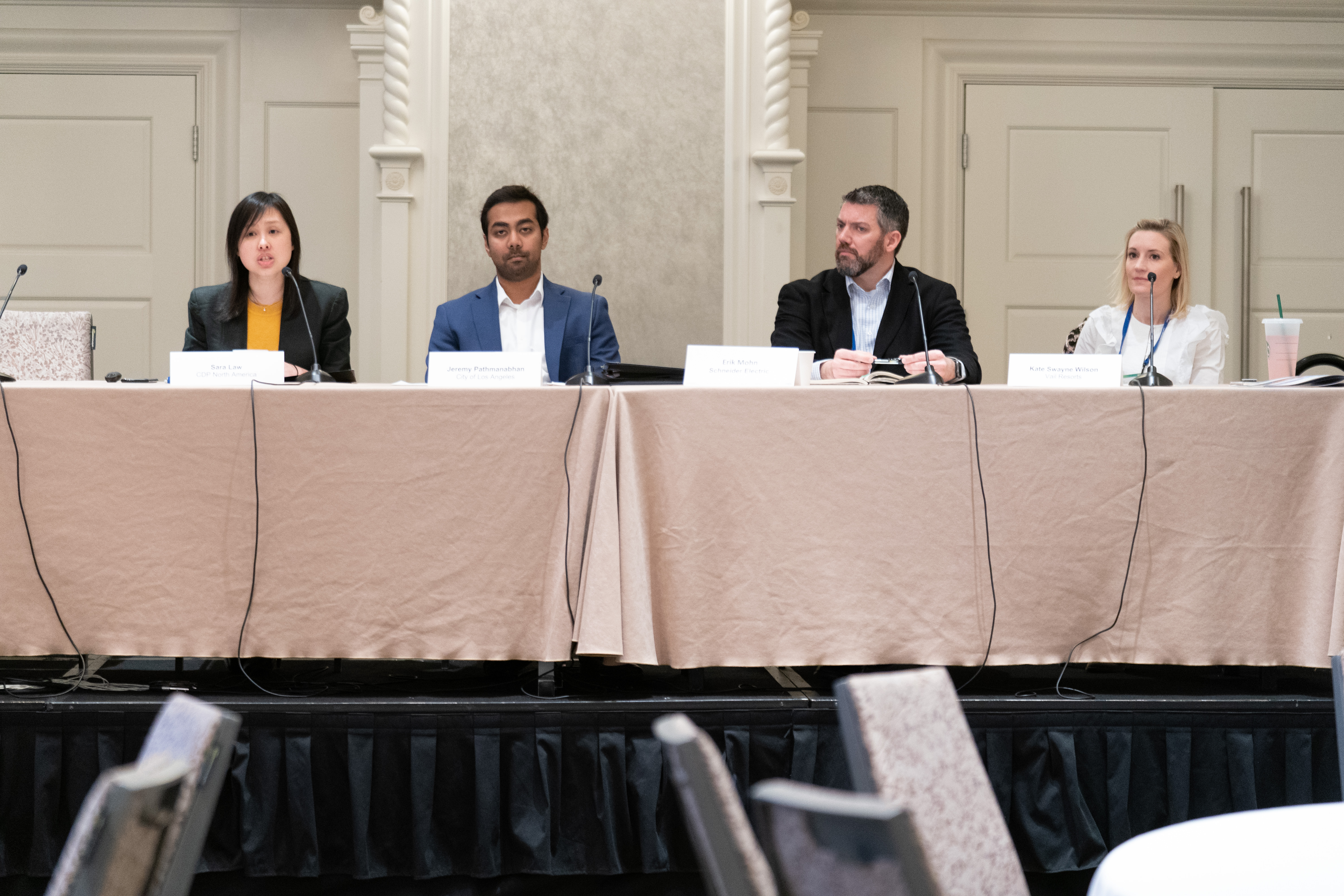
Sara Law, far left, speaking at the Climate Leadership Conference in Detroit, March 2019.
COVID-19 is a humanitarian crisis. COVID-19 is an economic crisis. This disaster is unfolding daily and, in all likelihood, will consume much effort in the months to come as companies fight to recover alongside the rest of society.
Sustainability practitioners are grappling with economic uncertainty and what it means for their businesses. I would like to offer this perspective: in our economic restoration, it will be more important than ever to operate sustainably, efficiently and with heightened awareness of ‘mega risks’ – like a dangerous changing climate.
In that spirit, it is critical that we think ‘big’ and act ‘big’ on climate change so we can be better prepared for future business disruptions while playing a vital role in helping to prevent them. That means setting your targets in line with 1.5°C and working to achieve net zero ASAP.
I spoke about this on two panels at the Climate Leadership Conference in Detroit last month, with the added message that climate ambition is great, and climate action is even better. In these conversations, I heard confusion around the differences between “net zero,” “carbon neutral” and “climate neutral” targets. I also heard uneasiness that climate goalposts seem to be shifting as the science evolves. Happily, no one was confused about the intent of such a target: the need for drastic emissions reductions to achieve a thriving global economy that works for people and planet.
Leadership is evolving (again).
Shifting goalposts are inevitable and can be a harbinger of progress and advancement.
A century ago, the horse-drawn carriage was swiftly replaced by the automobile. While I was in Detroit, I visited the Fisher Building, an art deco architectural masterpiece once home to Fisher Body Corporation, a company that transformed from being the leading manufacturer of horse-drawn carriages to a cornerstone maker of car body parts. Through its 100-year history, it continued to innovate, meet – and beat – changing expectations through its adaptiveness, and became a trendsetter in the automotive industry.
Vail Resorts is another example: this ski resort and hotel chain has adapted to a 41% drop in snowfall in the U.S. since the 1980s. This could easily be seen as an existential crisis for a business built to cater to winter sports tourism. But Vail has instead evolved to provide all-seasons activities at its resorts and lands, and committed to net zero emissions by 2030 because the climate crisis impacts its business firsthand.
Evolving climate leadership standards can stimulate business innovation and growth.
Aim for net zero, well before 2050.
Twenty years ago, it was rare to find any company measuring and reporting GHG emissions, let alone setting emissions reduction targets. Only six years ago, it was hard to persuade a company to set science-based targets. Today, over 200 companies have committed to setting science-based targets that align with 1.5°C. Now they are turning their attention to the long-term goal – net zero emissions well before 2050. I doubt any of the ‘first mover’ companies in each of these instances has come to regret the big first step they took.
So, how do you choose the right target for your business? Whether we talk about carbon neutrality, climate neutrality or net zero emissions, the intent is the same: to achieve the goal of neutralizing the impact of our activity on our climate and the planet.
The SBTi has presented the following guidance to achieving net zero emissions:
“Reaching net zero emissions for a company means achieving a state in which the activities within the value chain of a company result in no net impact on the climate from greenhouse gas emissions. This is achieved by reducing value chain greenhouse gas emissions, in line with 1.5°C pathways, and by balancing the impact of any remaining greenhouse gas emissions with an appropriate amount of carbon removals.”
By working with the SBTi and CDP, you can ensure that your company’s target is formulated to reduce emissions rapidly while ensuring profitability and long-term success.
Don’t press ‘pause’ on climate leadership.
Resist the urge to press ‘pause’ on climate leadership – because climate change isn’t stopping for anyone or anything. Those who place climate and sustainability at the heart of economic recovery will find themselves ahead of the pack.
We have already seen renewed calls for a more sustainable economy to emerge after the crisis. And science tells us we simply cannot wait. What’s more, your competitors are already setting ambitious targets, your investors are calling for action and growing sectors of your customer base want it.
Face uncertainty with steady leadership backed by science. You may not yet know how you will meet your target – many of the 1.5°C business leaders are not sure how exactly their commitments will unfold. Start cutting emissions now anyway. Take those ‘no regrets’ first steps because that is leadership by definition.
